| |
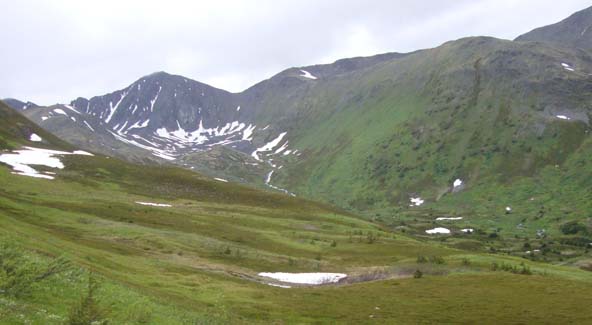 KENAI PENINSULA & KENAI FJORDS NP KENAI PENINSULA & KENAI FJORDS NP
BIRDS
We
rented a car and drove from Anchorage to Seward on the Kenai Peninsula.
One day we did an all-day boat trip in Kenai Fjords National Park. On
the other day we visited alpine tundra at the top of Palmer Creek Road,
near Hope, at the north end of the Kenai Peninsula (habitat; right).
This latter road passed through spruce-alder forest before reaching the
alpine zone, and along the dirt road we found a female Spruce Grouse
with precocial young (below left). She eventually flew up into a tree
(below right) for excellent views. Note the rufous-tipped tail that is
characteristic of the taiga races.
|
|
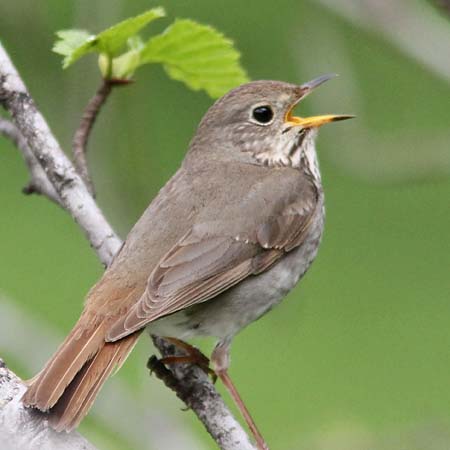 Up at the edge of the alpine zone there were singing Hermit Thrush in patches of short willows (left) and on the alpine tundra itself, American Pipit (just below). Up at the edge of the alpine zone there were singing Hermit Thrush in patches of short willows (left) and on the alpine tundra itself, American Pipit (just below).
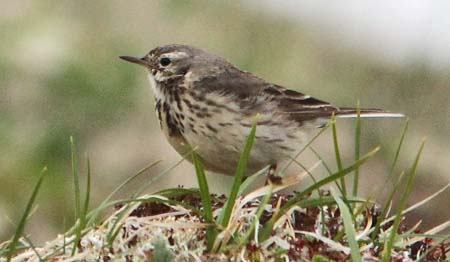
Then, along the road, our primary goal: Rock Ptarmigan
(below)! This pair had precocial young. We first noted the female
(below right) but it was the aggressive male (below left) that took
over the defense, flying straight at us several times to deter our
approach on foot. Note his red eye comb. We took a few snaps and left
them alone. |
|
|
|
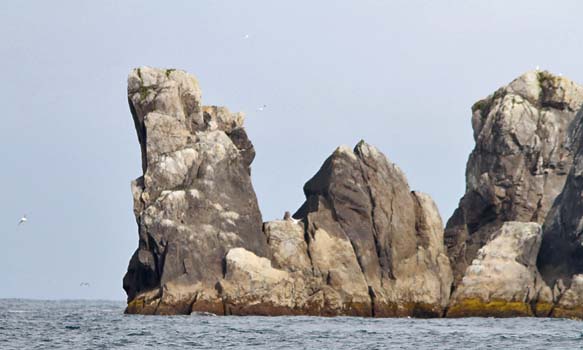 The major birding highlights, though, were the seabird colonies and the abundant of alcids within Kenai Fjords National Park, visited by fast boat (e.g., thousands of Common Murre, above). We chose to take the "Captain's Choice" cruise offered by Kenai Fjords Tours, a 9-hour ride in a small boat (limited to 16 passengers) that visits the Chiswell Islands NWR (right) and a calving glacier with the National Park. The major birding highlights, though, were the seabird colonies and the abundant of alcids within Kenai Fjords National Park, visited by fast boat (e.g., thousands of Common Murre, above). We chose to take the "Captain's Choice" cruise offered by Kenai Fjords Tours, a 9-hour ride in a small boat (limited to 16 passengers) that visits the Chiswell Islands NWR (right) and a calving glacier with the National Park.
The abundance of both species of Pacific puffins invariably brings smiles: Tufted Puffin (below left) and Horned Puffin (below right). |
|
|
|
|
|
Yet it is the presence of a smorgasboard of scarcer species that is the most satisfying (clockwise from upper right): Ancient Murrelet (this is a juv or first-summer bird), Rhinoceros Auklet, Thick-billed Murre, Parakeet Auklet, Red-faced Cormorant, Marbled Murrelet, and, best of all, Kittlitz's Murrelet (taking off). |
|
|
|
|
|
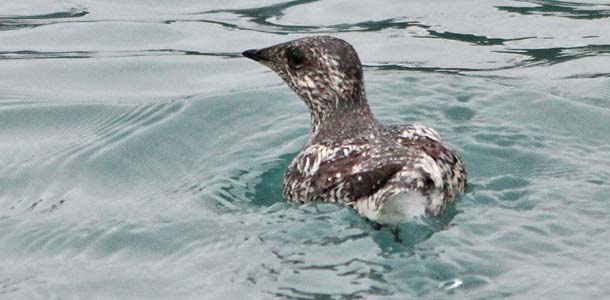 None
of us had ever viewed Kittlitz's Murrelet up close, so this was a real
treat. The birds were found only in the cold glacier water within a
couple miles of huge tidewater Aiatak Glacier. The "pairs" encountered
were almost surely adult males and young (shown just above; adult to
the left). This was very interesting because the juvenal plumage of
Kittlitz's was undescribed until Pierre Devillerspublished an account
of a juvenal-plumage bird found ashore on La Jolla beach, San Diego
Co., California, on 16 Aug 1969 (Devillers, 1972, "The juvenal plumage
of Kittlitz's Murrelet," Calif. Birds 3: 33-38). Few photos
of juvenal Kittlitz's have been published, so this post shows
individuals above, right, and below (left-hand bird). It illustrates
variation in juvenal plumage in July, as well as in adults. Compare the
adult above (left-hand bird) to the much brighter adult at the bottom
of this page. At all ages, note the very short bill of Kittlitz's
(compared to Marbled Murrelet), and the much greater 'salt-and-pepper'
coloration than the rich brown upperparts of Marbled Murrelet.
Kittlitz's also has white outer tail feathers, seen in flight [in the
collage above]. Also notice the black 'eye-patch' present to a degree
on all birds, formed primarily by a black crescent in front and and
below the eye. This shows particularly well on the bottom photo; the
eerie green-blue color of the glacier water is also apparent in that
shot. None
of us had ever viewed Kittlitz's Murrelet up close, so this was a real
treat. The birds were found only in the cold glacier water within a
couple miles of huge tidewater Aiatak Glacier. The "pairs" encountered
were almost surely adult males and young (shown just above; adult to
the left). This was very interesting because the juvenal plumage of
Kittlitz's was undescribed until Pierre Devillerspublished an account
of a juvenal-plumage bird found ashore on La Jolla beach, San Diego
Co., California, on 16 Aug 1969 (Devillers, 1972, "The juvenal plumage
of Kittlitz's Murrelet," Calif. Birds 3: 33-38). Few photos
of juvenal Kittlitz's have been published, so this post shows
individuals above, right, and below (left-hand bird). It illustrates
variation in juvenal plumage in July, as well as in adults. Compare the
adult above (left-hand bird) to the much brighter adult at the bottom
of this page. At all ages, note the very short bill of Kittlitz's
(compared to Marbled Murrelet), and the much greater 'salt-and-pepper'
coloration than the rich brown upperparts of Marbled Murrelet.
Kittlitz's also has white outer tail feathers, seen in flight [in the
collage above]. Also notice the black 'eye-patch' present to a degree
on all birds, formed primarily by a black crescent in front and and
below the eye. This shows particularly well on the bottom photo; the
eerie green-blue color of the glacier water is also apparent in that
shot.
|
|
|
| |
| |
|
|
|




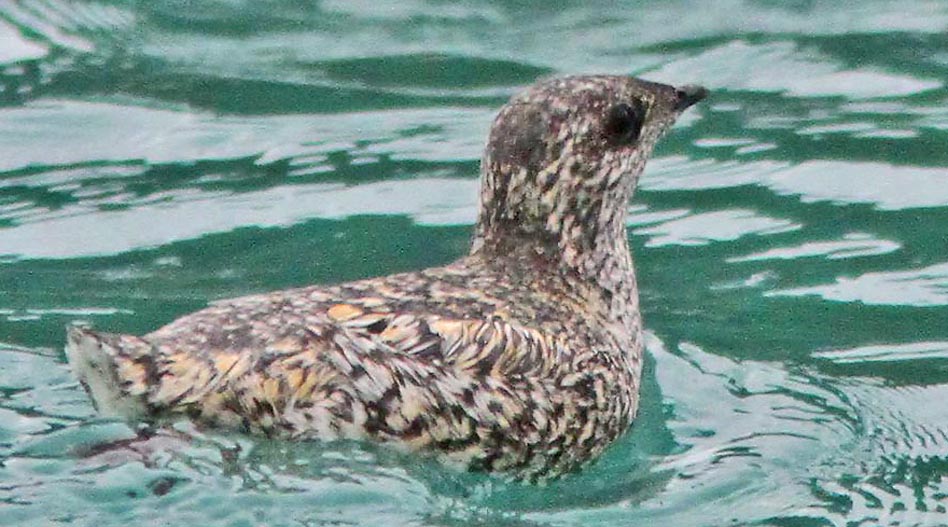
 KENAI PENINSULA & KENAI FJORDS NP
KENAI PENINSULA & KENAI FJORDS NP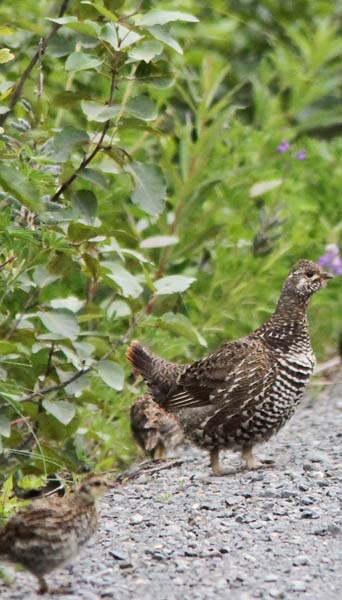
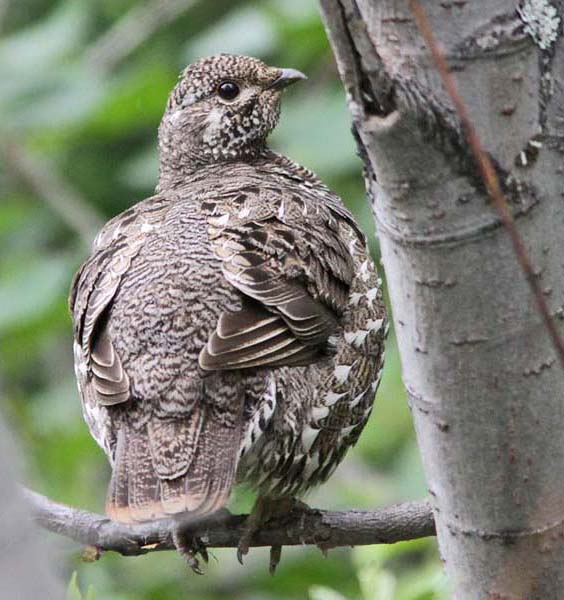
 Up at the edge of the alpine zone there were singing Hermit Thrush in patches of short willows (left) and on the alpine tundra itself, American Pipit (just below).
Up at the edge of the alpine zone there were singing Hermit Thrush in patches of short willows (left) and on the alpine tundra itself, American Pipit (just below). 


 The major birding highlights, though, were the seabird colonies and the abundant of alcids within Kenai Fjords National Park, visited by fast boat (e.g., thousands of Common Murre, above). We chose to take the "Captain's Choice" cruise offered by
The major birding highlights, though, were the seabird colonies and the abundant of alcids within Kenai Fjords National Park, visited by fast boat (e.g., thousands of Common Murre, above). We chose to take the "Captain's Choice" cruise offered by 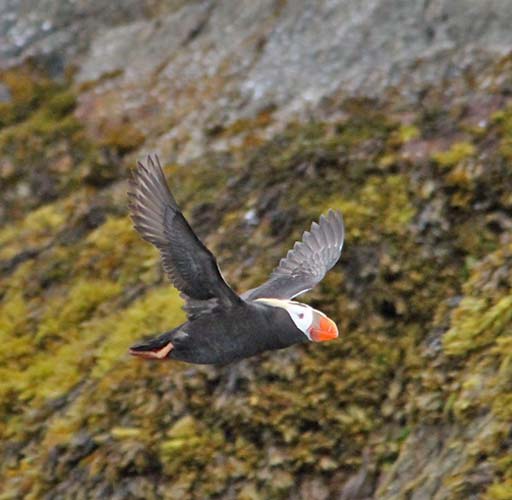
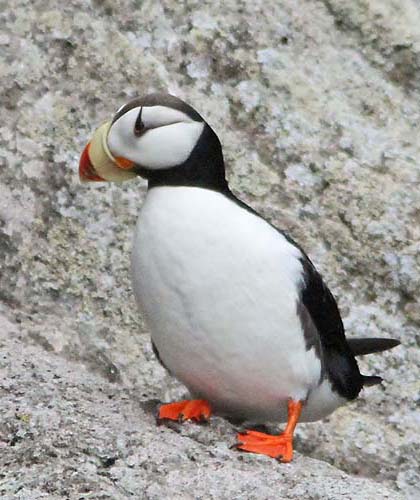
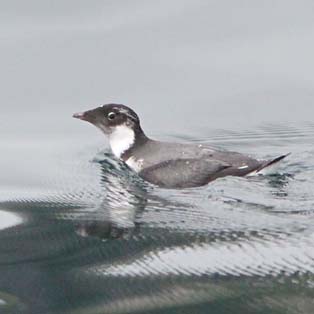
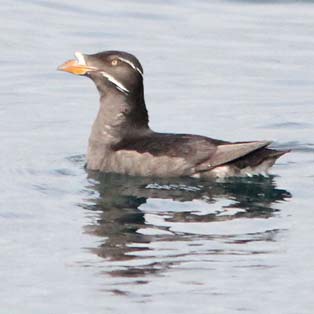
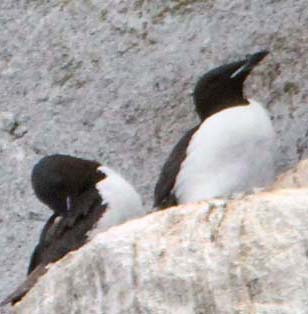
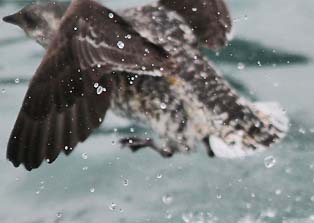
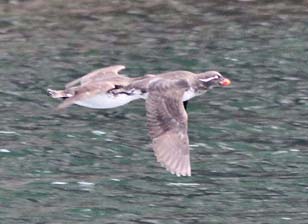
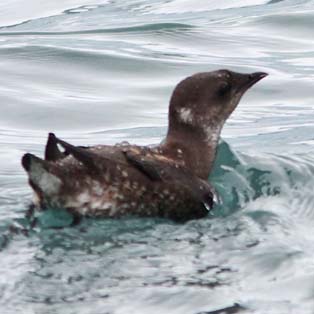
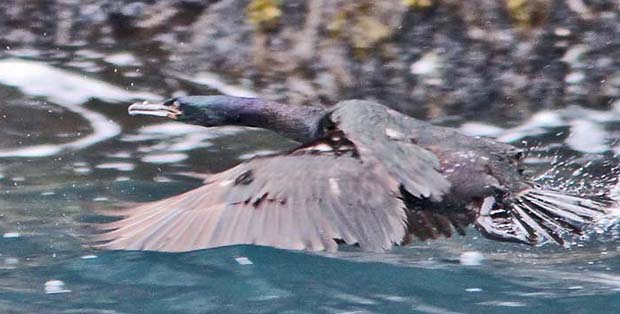
 None
of us had ever viewed Kittlitz's Murrelet up close, so this was a real
treat. The birds were found only in the cold glacier water within a
couple miles of huge tidewater Aiatak Glacier. The "pairs" encountered
were almost surely adult males and young (shown just above; adult to
the left). This was very interesting because the juvenal plumage of
Kittlitz's was undescribed until Pierre Devillerspublished an account
of a juvenal-plumage bird found ashore on La Jolla beach, San Diego
Co., California, on 16 Aug 1969 (Devillers, 1972, "The juvenal plumage
of Kittlitz's Murrelet," Calif. Birds 3: 33-38). Few photos
of juvenal Kittlitz's have been published, so this post shows
individuals above, right, and below (left-hand bird). It illustrates
variation in juvenal plumage in July, as well as in adults. Compare the
adult above (left-hand bird) to the much brighter adult at the bottom
of this page. At all ages, note the very short bill of Kittlitz's
(compared to Marbled Murrelet), and the much greater 'salt-and-pepper'
coloration than the rich brown upperparts of Marbled Murrelet.
Kittlitz's also has white outer tail feathers, seen in flight [in the
collage above]. Also notice the black 'eye-patch' present to a degree
on all birds, formed primarily by a black crescent in front and and
below the eye. This shows particularly well on the bottom photo; the
eerie green-blue color of the glacier water is also apparent in that
shot.
None
of us had ever viewed Kittlitz's Murrelet up close, so this was a real
treat. The birds were found only in the cold glacier water within a
couple miles of huge tidewater Aiatak Glacier. The "pairs" encountered
were almost surely adult males and young (shown just above; adult to
the left). This was very interesting because the juvenal plumage of
Kittlitz's was undescribed until Pierre Devillerspublished an account
of a juvenal-plumage bird found ashore on La Jolla beach, San Diego
Co., California, on 16 Aug 1969 (Devillers, 1972, "The juvenal plumage
of Kittlitz's Murrelet," Calif. Birds 3: 33-38). Few photos
of juvenal Kittlitz's have been published, so this post shows
individuals above, right, and below (left-hand bird). It illustrates
variation in juvenal plumage in July, as well as in adults. Compare the
adult above (left-hand bird) to the much brighter adult at the bottom
of this page. At all ages, note the very short bill of Kittlitz's
(compared to Marbled Murrelet), and the much greater 'salt-and-pepper'
coloration than the rich brown upperparts of Marbled Murrelet.
Kittlitz's also has white outer tail feathers, seen in flight [in the
collage above]. Also notice the black 'eye-patch' present to a degree
on all birds, formed primarily by a black crescent in front and and
below the eye. This shows particularly well on the bottom photo; the
eerie green-blue color of the glacier water is also apparent in that
shot.